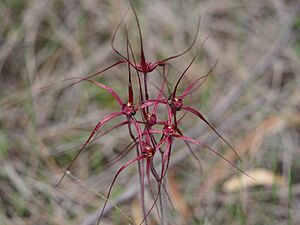Blood spider orchid facts for kids
Quick facts for kids Blood spider orchid |
|
|---|---|
 |
|
| Scientific classification | |
| Genus: |
Caladenia
|
| Species: |
filifera
|
| Synonyms | |
The blood spider orchid (scientific name: Caladenia filifera) is a special type of orchid. It grows only in the south-west part of Western Australia. This orchid is quite common where it lives. It often grows in groups, forming small clumps. Each plant has one fuzzy leaf and can have up to three bright blood-red flowers.
Contents
What Does the Blood Spider Orchid Look Like?
The blood spider orchid is a plant that grows from the ground. It's a perennial plant, meaning it lives for more than two years. It's also deciduous, so its leaves fall off during certain seasons. This plant is a herb, which means it has soft stems, not woody ones like a tree.
It grows from an underground tuber, which is like a small, round storage organ. Often, these orchids grow together in small groups or clumps. Each plant has a single leaf that stands straight up. This leaf is covered in tiny hairs and is about 6 to 15 centimeters (2.4 to 5.9 inches) long and 2 to 4 millimeters (0.08 to 0.16 inches) wide.
The flowers are a striking blood-red color. There can be up to three flowers on a single stem, which stands about 15 to 35 centimeters (5.9 to 13.8 inches) tall. Each flower is quite large, about 10 to 12 centimeters (3.9 to 4.7 inches) long and 6 to 8 centimeters (2.4 to 3.1 inches) wide.
Let's look closer at the flower parts:
- The dorsal sepal is the top part of the flower. It stands upright and is about 5 to 10 centimeters (2.0 to 3.9 inches) long.
- The lateral sepals and petals are similar in size and shape to the dorsal sepal. These parts start out flat near the base. Then, they become very thin and wispy, hanging downwards like threads. This is why it's called a "spider orchid"!
- The labellum is a special lip-like part of the orchid. It's about 1 to 1.5 centimeters (0.39 to 0.59 inches) long and 0.6 to 1 centimeter (0.24 to 0.39 inches) wide. The labellum is entirely blood-red, sometimes with a few darker spots. It might be white near its base.
- The sides of the labellum have short, blunt teeth. Its tip curves downwards.
- There are two rows of anvil-shaped bumps called calli along the center of the labellum.
These beautiful orchids bloom from August to October.
How Was the Blood Spider Orchid Named?
The blood spider orchid was first officially described in 1840. A botanist named John Lindley wrote about it in a book called A Sketch of the Vegetation of the Swan River Colony.
The scientific name filifera comes from two Latin words. The word filum means "a thread." The ending -fero means "to bear" or "to carry." So, filifera means "thread-bearing," which perfectly describes the wispy, thread-like parts of its flowers!
Where Does the Blood Spider Orchid Live?
You can find the blood spider orchid in specific areas of Western Australia. These areas include near Watheroo, in the Avon Wheatbelt, and the Jarrah Forest regions.
It prefers to grow in well-drained soils. You can find it in forests and scrubland. Interestingly, its flowering is encouraged by fires that happened in the previous summer. In the past, this orchid grew in more places. However, its range has become smaller because of changes in how fires happen in its habitat.
Is the Blood Spider Orchid Protected?
The Government of Western Australia's Department of Parks and Wildlife has looked at the blood spider orchid. They have classified it as "not threatened." This means that currently, there are enough of these orchids, and they are not at risk of disappearing.


